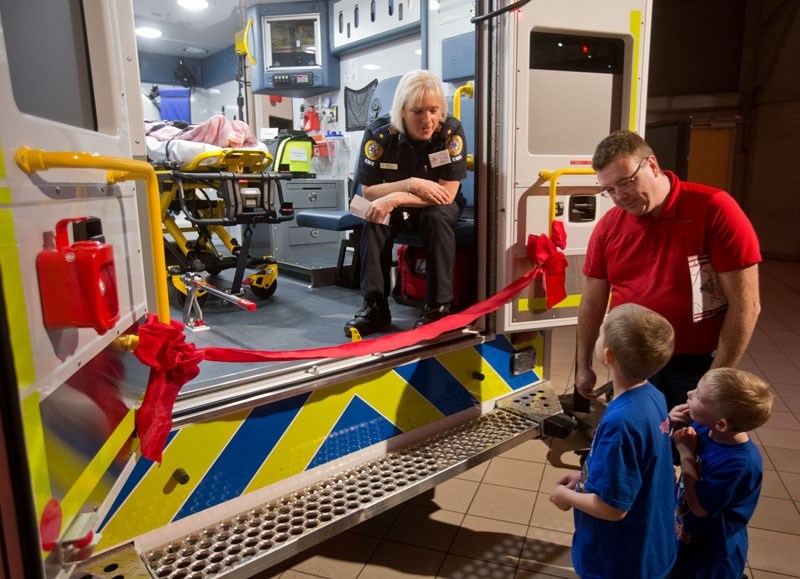The brightly decorated conifers at the Festival of Trees harness the spirit of the season.
This year, a life-saving spirit of the season is also on display among the twinkling forest at the Shaw Conference Centre.
This past Monday, the University of Alberta Hospital and the University Hospital Foundation unveiled Canada’s first stroke ambulance.
Larger than a normal ambulance, it is a mobile treatment centre outfitted with a CT scanner, clot-busting drugs, as well as video and audio communications technology. It has the potential to stabilize a stroke before a patient reaches a hospital.
Headquartered at the University Of Alberta Hospital, this two-ton emergency room on wheels will travel to stroke patients in rural areas within a 250-kilometre radius of Edmonton.
As the ambulance from whatever town is rushing the patient to Edmonton, the boxy-shaped stroke ambulance travelling at highway speeds will meet it halfway, and its medical crew will immediately start stroke care.
“Strokes are devastating. They are a major source of mortality,” said Dr. Thomas Jeerakthil, a stroke neurologist and co-principal investigator with Dr. Ashfaq Shuaib, director of the hospital stroke program.
“Once a patient develops a stroke, they lose two million brain cells every minute. If you delay too long, it can mean their brain function will be limited. Speed is of the essence. But before you treat a stroke, you need to give a brain scan,” Jeerakthil added.
From the onset of a stroke that quietly kills the brain, doctors have a short window of four hours to treat it. After that, the brain has for all intents and purposes died.
Patients can develop two forms of stroke. One requires clot-busting drugs that break up a blood clot that is causing a blockage or disruption to the brain.
The other is a bleed in the brain. If clot-busting drugs are applied to the bleed, it can kill a patient. A quick scan relays the difference and the precise life-saving treatment can be applied.
A stroke ambulance is a fairly new concept. Only about a dozen are in use worldwide. The United States operates five.
“We’ve combined features from stroke ambulances across the world and built one for a Canadian winter climate.”
In addition to a state-of-the-art heating and cooling system, the stroke ambulance is equipped with a leveling system. Once a patient is transferred to the ambulance, a hydraulic set of feet is pushed into the snow making sure the CT scanner is perfectly level to operate.
“We can scan within minutes and make a treatment. Using TeleStroke (video conference equipment), I can sit at the hospital and examine the patient in the ambulance and make a diagnosis right away.”
While helicopters can also shorten time, they have certain limitations.
“The problem we encountered is that they are restricted by weather patterns. We may in some situations dispatch a helicopter to meet the stroke ambulance and put the patient in the helicopter to be taken to the hospital.”
In 2015 about 6,000 stroke victims were admitted to provincial hospitals. Of that total, 2,500 were admitted in Edmonton and one in four were from rural areas.
The price tag for the stroke ambulance is pegged at $3.3 million. A significant portion is donated through the University Hospital Foundation’s Brain Centre Campaign.
After the stroke ambulance has passed mandatory provincial safety tests it will begin operating in Jan. 2017.
“It’s a project with a significant cost, but it is funded mainly by philanthropy. We plan to monitor its effectiveness with patients and its cost effectiveness.”




